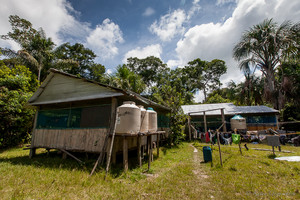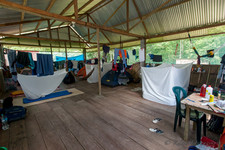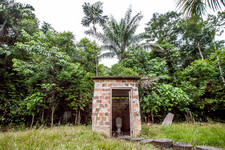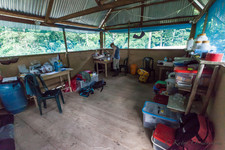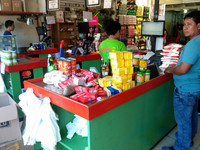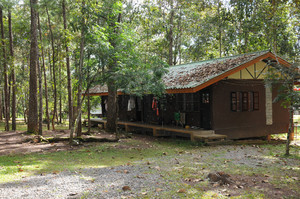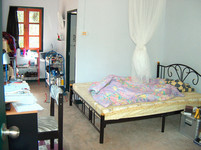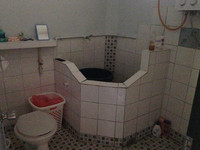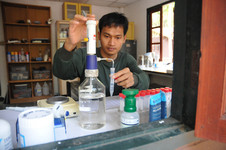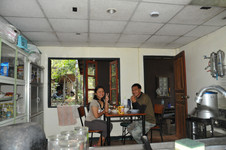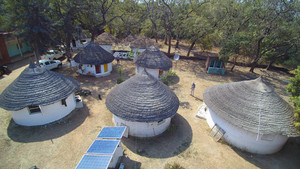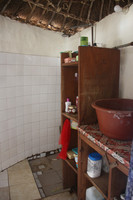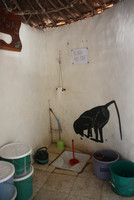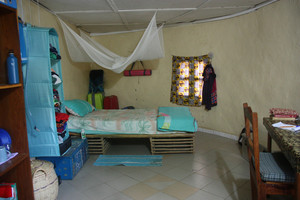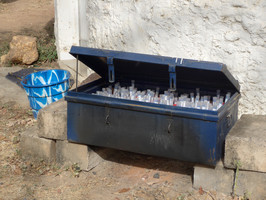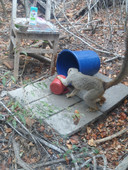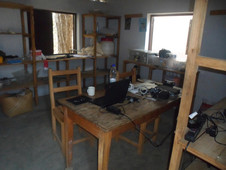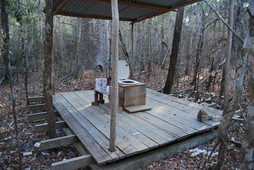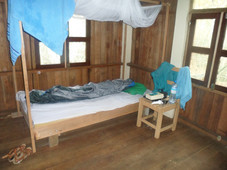Life in the wild
Peru, Senegal, Northern Guinea, Madagascar, Thailand: The DPZ operates five field stations on three continents to study the behaviour and ecology of different primate species. So far, the DPZ has regularly reported on the latest research results from the field stations. Now we want to take a look behind the scenes and find out what everyday life is like for researchers in these exotic countries.
Here we report on the daily routines of the researchers at the stations in Peru, Thailand, Senegal and Madagascar. How do they live? What is a typical working day like? What do the researchers do after work and how do they spend their days off?
Peru
The Peruvian Estación Biológica Quebrada Blanco (EBQB) is located on the world's most water-rich river, the Amazon. The tropical rainforests are home to many new world monkeys - the study subjects of the researchers.
The EBQB field station consists of three wooden houses, which stand next to each other in a clearing of the forest near a small river. One of the houses functions as the main sleeping area. Here the researchers sleep on the floor with a sleeping mat and sleeping bag either in a tent or under a mosquito net. The second house serves as kitchen, dining and living area and can be used as an extended sleeping space if needed. The third and smallest building is both, a simple laboratory and storage room. Like the other stations, the EBQB has a few solar cells that provide enough power for laptops, batteries, GPS devices and lamps. However, there is no internet connection. A small toilet block, which even has a flush, stands a little apart from the other houses. For showers, the camp residents go to a nearby stream. "The water in the stream is always cold, but clean and clear. And after the shower you are definitely awake again," laughs Master's student Katherina Tesar. Rainwater, which is collected via gutters and stored in large tanks, is the main water supplier and provides not just water for the toilet flush but for drinking, cleaning and laundry.
The daily routines in the Peruvian field station can vary depending on the season, the number of camp residents, and on the researcher’s study species. "If you want to study tamarins or titi monkeys, you often have to leave camp before sunrise. On the other hand, those who are studying the local flora can of course sleep longer," says Eckhard Heymann, head of the field station. Most of the researchers at the station, however, belong to the first group and therefore get up between 5 and 6 a.m. and set off to the monkeys in small teams after a small breakfast. From 7 a.m. to 4 p.m., behavioural data and samples are collected. At lunchtime, part of the team heads back to camp. Depending on whether or not a cook has been hired for the season, those returning are now responsible for preparing lunch or can have something to eat right away and take a break. They then return to the forest to relieve the others, who then take their lunch break. "This ensures that we don't lose sight of the primates and we might not find them anymore for the rest of the day," reports Katherina Tesar.
Around 4 p.m., when the monkeys go to sleep, the researchers finish their observations and return to the field sttion. After a shower, they process the last data and samples, cook dinner and eat. As the mosquitoes arrive in large numbers with the sunset around 6 p.m., some researchers immediately move to their tents, where they often read or watch films. Others, however, stay out a little longer for a chat or a game, but by 9 p.m. everyone is in bed. On days off, the researchers like to visit neighbouring villages and watch local football matches, or they relax at the station.
Thailand
The Phu Khieo Wildlife Sanctuary (PKWS) research station is located in north-eastern Thailand and is part of the Western Isaan Forest Complex, a large forested area on the border to Laos. Here, researchers study the social behaviour of Assamese macaques.
The station is 45 km inside a protected area and can be reached by a road. The camp has two residential buildings with four rooms each, which are equipped with a bed, table, chair, shelf and private bathroom. Two other buildings provide space for smaller offices, laboratories and common rooms as well as a small kitchen where the researchers can prepare their breakfast and small snacks for the day. Between the buildings is a large table, which is used for work meetings as well as social gatherings. Electricity in camp comes from solar panels and water is pumped from a nearby lake via a pipe system. There is also WIFI, which is sufficient for emails and mobile phone messages. To get to the actual research area, which is even deeper inside the protected area, the staff have several motorbikes at their disposal.
In the PKWS, the researchers work in shifts with an early shift and an afternoon shift. The team of the early shift has to leave camp between 4:30 and 5:30 am in order to be with the macaques in time before they leave their sleeping trees. The time when the early shift has to leave camp is thus, decided by how far away from the station the animals have spent their night. Getting to the animals often takes more than an hour. The early shift stays with the monkeys until about 12:30 p.m. before the team of the afternoon shift meets up with them and releases them from their duties. Back at the field station, which is usually around 2 pm, the early shift takes a shower and gets something to eat. Afterwards, they process collected samples, enter data into databases and take a break. The afternoon shift stays with the monkeys until they settle in a tree to sleep. Depending on the season and the mood of the macaques, this happens between 4 and 6 pm. Only when the researchers are certain that the monkeys have chosen their sleeping tree for the night and will stay there until the next morning do they start their way home and return to the field station usually between 5:30 and 7 p.m. After showering, there may be some time to process samples and enter data into databases before having dinner with the team of the morning shift. Afterwards, they either enjoy their free time or finish some more work in the office. Between 9 and 10 p.m. marks bedtime for most camp residents.
On their days off at the field station, the researchers often do chores around camp, go for a walk, read books or watch films. "In my free time, I like to go for a run. But of course, I only run along the road and not through the dense forest," reports Baptiste Sadoughi, a PhD student in the Department of Behavioural Ecology at Göttingen University. The researchers also regularly use their free time to travel to larger cities (1-3 hours' drive) for 1-2 days, where they stock up on their private food supplies, treat themselves to a little more comfort in a hotel and enjoy tasty Thai cuisine in restaurants.
Senegal
The Centre de Recherche de Primatologie Simenti is located in the largest national park of West Africa, the Niokolo Koba National Park. Here, researchers investigate ecology and behaviour of Guinea baboons.
The field station resembles a small village. There are several huts, consisting of two separate rooms, each for one person. The rooms are equipped with a bed, chair, desk, shelf and (very important) a fan. At the station are two washrooms, each with a sink and a toilet, and one of the washrooms also has a shower area. Drinking water comes from a self-made well, while water for showering, cooking and laundry is pumped directly into the camp from the nearby river. Basic electricity needs are met by solar panels and there is even WIFI. There is also a smaller hut that serves as a storage room and another one that provides a provisional laboratory where, for example, faecal samples can be processed or made ready for transport. In a kitchenette, researchers can prepare a small breakfast and simple snacks. A fireplace on the floor of the actual kitchen is used for the preparation of the bigger meals for all residents. Most of the social life takes place outside between the huts, where benches, chairs and a table make up the communal and dining area.
Before sunrise between 5:30 and 6:00 am, the researchers get up and ready for the day and march off in teams between 6:30 and 7:00 a.m.to the different baboon groups. "Depending on where the animals spent the night, this morning march can take between 10 and 60 minutes. Sometimes we take one of the camp cars if the animals are too far away for walking," says Irene Gutiérrez Díez, head of the field station. Depending on their research question, the scientists then begin with their behavioural observations and experiments or collect samples, for example of faeces or food plants. Around 1 p.m., they return to the camp, where lunch is waiting. After lunch, people like to chat a bit over tea before getting back to work. The afternoons are usually quiet, as the researchers stay at the field station to enter their data into computers, process collected samples or do chores around the camp. After dinner, which takes place around 8 p.m., the team meets for organisational matters, such as planning future field visits or setting up teams for the following day.
The camp residents use their free time to recover from the physical strain of the working days. They watch films or series together in the camp, play games and read books. Irene Gutiérrez Díez also reveals an insider tip: Taking a stroll to the Mare, a small watering hole a few hundred metres away from camp. "Especially at dusk, you can see all kinds of animals that come by to drink," she says. Once a month, the researchers go for a few days to the next town called Tambacounda, where they rent an apartment. Apart from small shopping trips, visits to a nearby hotel swimming pool are on the agenda, and provide a great opportunity to cool down on particularly hot days – temperatures may well rise above 40 degrees.
Madagascar
The DPZ field station Kirindy Forest is located in Western Madagascar, one of the most important biodiversity hotspots in the world. Here, lemurs, which only occur on the island state, are the main focus of research.
The field station consists of several central stone huts and surrounding wooden cabins. The stone huts provide accommodation for the field assistants, and further contain the kitchen, communal, storage and technical rooms, and a simple laboratory. The researchers sleep in the wooden cabins that stand separate from each other and can be reached via trails. The cabins are furnished with a bed, mosquito nets, chair and shelf but have no electricity. Solar panels provide power for the stone cabins and produce sufficient electricity for laptops, lights, fans, fridges and freezers. They also allow for a limited amount of hot water for showering. The sanitary facilities in camp are fairly basic. There are two toilets literally standing in the middle of the forest on wooden platforms. They are, however covered by a roof and protected from prying eyes by the dense forest. As the power supply does not reach that far into the forest to equip the toilets with lamps, a headlamp is recommended for night-time visits. Water for showering is fetched with buckets from taps in the centre of the camp and shower places are directly next to the researcher’s wooden cabins. The whole water supply for the field station comes from a well in a nearby village, where it gets collected by car in large canisters and stored in a water tower.
For most researchers, a workday in camp starts around 6 a.m. After breakfast, they walk or cycle to the research area in the forest, which is about two kilometers away. After finding their radio-tagged study subjects (e.g. red-fronted lemurs or Verreaux’s sifakas) with an antenna, behavioural observations and sample collection begins around 7:30. Around 11 a.m. the researchers head back to camp for a lunch break, and continue their observations in the forest between 1:30 and 4:30 p.m. Back in camp in the evening, sweat and dirt of the day is washed off with a refreshing shower before any last data is entered into the laptops or samples are processed in the lab. After dinner around 6:30 p.m., people like to chat, play cards or retire to their cabins, where they end the day with movies or books. By 10 p.m. most camp residents are fast asleep. "Unless you are studying nocturnal lemurs like I do. Then you may sometimes work until midnight, but have more free time during the day," says PhD student Johanna Henke - von der Malsburg.
Every other weekend, the researchers travel by car to the next town, Morondava, where they spend a few days off. In town, they stay in a fully equipped house where they are self-sufficient. In Morondava, most researchers spend their free time by contacting friends and family (there is no internet in the field station), strolling through the city, visiting the beach, eating out in restaurants or cooking by themselves. People also like to browse through the books that the former visitors of the last 20 years have left behind in the house. This small "library" contains everything from doctoral theses and non-fiction books to classics ("The Neverending Story" or "The Lost World"), historical novels ("The Physician") and thrillers ("Retribution"). Thereby, the international diversity of the researchers is reflected in the many different languages of the books.

